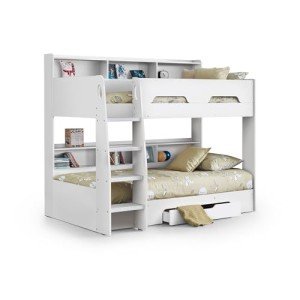The Bunks Awards: The Best, Worst, And The Most Bizarre Things We've Seen

Bunks: The Versatile Space-Saving Solution for Modern Living
In today's busy world, where urban living areas are shrinking and the need for flexibility and practicality is increasing, bunks have emerged as a popular solution. Bunks are not simply a kind of bed; they represent an advanced approach to taking full advantage of space, promoting social interaction, and supplying comfortable sleeping plans. This post will explore the numerous kinds of bunks offered, their advantages, and how they can change both small and big living areas.
Comprehending Bunks: What Are They?
Bunks, typically referred to as bunk beds, are 2 or more beds stacked on top of each other. They are developed to conserve flooring space, making them ideal for kids's rooms, hostels, and even adult living circumstances. Bunk beds are offered in various designs and setups, from conventional models to modern-day, designer interpretations.
Kinds of Bunks
| Type of Bunk | Description |
|---|---|
| Twin-over-Twin | Two twin beds stacked on top of each other. Suitable for kids sharing a space. |
| Twin-over-Full | A twin bed on the top and a bigger full bed on the bottom. Great for accommodating visitors. |
| Full-over-Full | 2 full-sized beds stacked together. Perfect for older children or adults. |
| L-Shaped Bunk Bed | Beds are arranged in an L shape, permitting a corner positioning and added space underneath. |
| Loft Beds | Only the top bunk is present, leaving space for a desk, couch, or storage underneath. |
| Triple Bunk Beds | 3 beds stacked vertically, excellent for taking full advantage of vertical space. |
Benefits of Using Bunks
- Space Efficiency: Bunks are created to use vertical space, making them ideal for small bed rooms or apartments where flooring space is restricted.
- Affordable: Investing in a bunk bed can be more economical than purchasing numerous separate beds, especially for growing families or those with regular guests.
- Versatile Designs: Many bunks included add-ons, such as desks, storage drawers, or futons, enabling for flexible use of the location.
- Social Interaction: Bunk beds welcome friendship amongst brother or sisters and good friends, promoting a sense of connection.
- Creative Use of Space: Bunk beds encourage imagination in room design, permitting spirited themes and vibrant design that can make a bed room feel special and inviting.
Practical Considerations
- Height Limitations: When choosing a bunk bed, it is necessary to consider the height of the ceiling in the room. Procedure the space to make sure there is adequate clearance above the leading bunk for safety and comfort.
- Weight Restrictions: Each bunk has a particular weight limitation. Parents must examine the weight of those utilizing it, particularly in the case of adults or much heavier adolescents sharing the bed.
- Safety Features: Features such as guardrails, tough ladders, and safety accreditations are essential for ensuring the bunk bed's safety, particularly for younger users.
Bunks for Various Living Situations
Family Homes
In family homes, bunks provide a practical solution for brother or sisters sharing a space or accommodating sleepovers. Bunk beds can be stylishly incorporated into a kid's space while providing sufficient space for play.
Hostels and Vacation Rentals
For hostels and trip leasings, bunk beds make the most of sleeping arrangements without compromising convenience. Such setups offer a cost-effective method to accommodate a bigger variety of guests.
College Dormitories
In college dorms, bunks help make the many of the minimal square video footage readily available, enabling more space to socialize and study.
Small Apartments
In little metropolitan apartments, lofted bunk beds develop extra space for living areas, workspaces, or storage, making life more workable in compact environments.
Maintenance and Care of Bunks
Preserving a bunk bed is necessary for ensuring its durability. Here are a few pointers:
- Regular Inspections: Check for any loose screws or bolts and tighten them as required.
- Tidiness: Dust and tidy the bunks frequently to prevent allergens and make sure a tidy sleeping environment.
- Bed mattress Care: Use a quality bed mattress protector to keep health and extend the life of the mattress.
- Age Appropriateness: Upgrade to a larger, more sturdy bunk as children grow or when the existing arrangement no longer satisfies the requirements of its occupants.
Regularly Asked Questions (FAQs)
1. Are bunk beds safe for kids?
Yes, bunk beds can be safe for children if they are constructed with security features like guardrails and a stable ladder. Always supervise more youthful kids when they are using bunk beds.
2. What age is appropriate for a kid to sleep on the leading bunk?
Most producers recommend that kids under the age of 6 must not sleep on the upper bunk due to security concerns.
3. Just how much weight can bunk beds generally hold?
Weight capacities vary based upon the style and products however normally range from 200 to 400 pounds. Constantly inspect the producer's standards.
4. Can bunk beds be separated into two single beds?
Lots of bunk beds are designed to be convertible, permitting them to be separated into two individual beds. It's important to examine the product specifications before buying.
5. What kind of mattress is best for a bunk bed?
A medium-firm mattress is often recommended as it supplies sufficient assistance without being too heavy or soft, which can pose safety concerns.
Bunks are more than simply beds. Kids Bunk Bed are innovative space-saving options that cater to the needs of modern living. With different styles readily available, they supply convenience and performance for families, guests, and people alike. By focusing on safety and upkeep, owners can ensure that their bunk beds become a cherished part of their home for several years to come. Whether for playful children or accommodating visitors, bunk beds offer a stylish and practical solution to the challenge of limited space.

